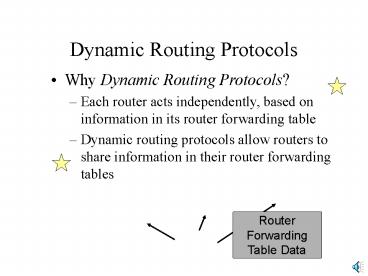Dynamic Routing Protocols - PowerPoint PPT Presentation
Title:
Dynamic Routing Protocols
Description:
Dynamic Routing Protocols Why Dynamic Routing Protocols? Each router acts independently, based on information in its router forwarding table Dynamic routing protocols ... – PowerPoint PPT presentation
Number of Views:212
Avg rating:3.0/5.0
Title: Dynamic Routing Protocols
1
Dynamic Routing Protocols
- Why Dynamic Routing Protocols?
- Each router acts independently, based on
information in its router forwarding table - Dynamic routing protocols allow routers to share
information in their router forwarding tables
Router Forwarding Table Data
2
Routing Information Protocol (RIP)
- Routing Information protocol (RIP) is the
simplest dynamic routing protocol - Each router broadcasts its entire routing table
frequently - Broadcasting makes RIP unsuitable for large
networks
Routing Table
3
Routing Information Protocol (RIP)
- RIP is the simplest dynamic routing protocol
- Broadcasts go to hosts as well as to routers
- RIP interrupts hosts frequently, slowing them
down Unsuitable for large networks
Routing Table
4
Routing Information Protocol (RIP)
- RIP is Limited
- RIP routing table has a field to indicate the
number of router hops to a distant host - The RIP maximum is 15 hops
- Farther networks are ignored
- Unsuitable for very large networks
Hop
Hop
5
Routing Information Protocol
- Is a Distance Vector Protocol
- New York starts, announces itself with a RIP
broadcast - Chicago learns that New York is one hop away
- Passes this on in its broadcasts
NY is 1
New York
Chicago
Dallas
1 hop
6
Routing Information Protocol
- Learning Routing Information
- Dallas receives broadcast from Chicago
- Already knows Chicago is one hop from Dallas
- So New York must be two hops from Dallas
- Places this information in its routing table
NY is 1
New York
Chicago
Dallas
1 hop
1 hop
NY is 2
7
Routing Information Protocol
- Slow Convergence
- Convergence is getting correct routing tables
after a failure in a router or link - RIP converges very slowly
- May take minutes
- During that time, many packets may be lost
8
Routing Information Protocol
- Encapsulation
- Carried in data field of UDP datagram
- Port number is 520
- UDP is unreliable, so RIP messages do not always
get through - A single lost RIP message does little or no harm
UDP Header
UDP Data Field RIP Message
9
OSPF Routing Protocol
- Link State Protocol
- Link is connection between two routers
- OSPF routing table stores more information about
each link than just its hop count cost,
reliability, etc. - Allows OSPF routers to optimize routing based on
these variables
Link
10
OSPF Routers
- Network is Divided into Areas
- Each area has a designated router
Area
Designated Router
11
OSPF Routers
- When a router senses a link state change
- Sends this information to the designated router
Area
Designated Router
Notice of Link State Change
12
OSPF Routers
- Designed Router Notifies all Routers
- Within its area
Area
Designated Router
Notice of Link State Change
13
OSPF Routers
- Efficient
- Only routers are informed (not hosts)
- Usually only updates are transmitted, not whole
tables
Area
Designated Router
Notice of Link State Change
14
OSPF
- Fast Convergence
- When a failure occurs, a router transmits the
notice to the designated router - Designated router send the information back out
to other routers immediately
15
OSPF
- Encapsulation
- Carried in data field of IP packet
- Protocol value is 89
- IP is unreliable, so OSPF messages do not always
get through - A single lost OSPF message does little or no harm
IP Header
IP Data Field OSPF Message
16
Selecting RIP or OSPF
- Within a network you control, it is your choice
- Your network is an autonomous system
- Select RIP or OSPF based on your needs
- Interior routing protocol
17
Selecting RIP or OSPF
- RIP is fine for small networks
- Easy to implementing
- 15 hops is not a problem
- Broadcasting, interrupting hosts are not too
important
18
Selecting RIP or OSPF
- OSPF is Scalable
- Works with networks of any size
- Management complexities are worth the cost in
large networks
19
Border Gateway Protocol (BGP)
- To connect different autonomous systems
- Must standardize cross-system routing information
exchanges - BGP is most popular today
- Gateway is the old name for router
- Exterior routing protocol
Autonomous System
Autonomous System
BGP
20
Border Gateway Protocol (BGP)
- Distance vector approach
- Number of hops to a distant system is stored in
the router forwarding table - Normally only sends updates
Autonomous System
Autonomous System
BGP
21
Border Gateway Protocol (BGP)
- Encapsulation
- BGP uses TCP for delivery
- Reliable
- TCP is only for one-to-one connections
- If have several external routers, must establish
a TCP and BGP connection to each
Autonomous System
Autonomous System
BGP































